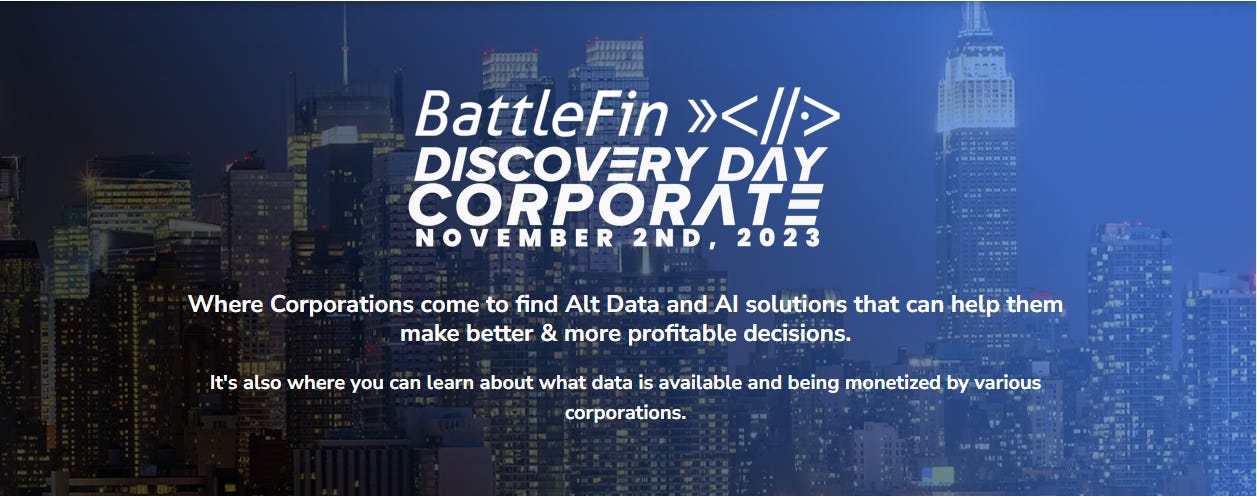Top Questions ahead of BattleFin Corporate Discovery Day
Battlefin is hosting an interesting event on November 2, 2023, in New York City. Here are the questions on my mind for the speakers.
Welcome to the Data Score newsletter, composed by DataChorus LLC. The newsletter is your go-to source for insights into the world of data-driven decision-making. Whether you're an insight seeker, a unique data company, a software-as-a-service provider, or an investor, this newsletter is for you. I'm Jason DeRise, a seasoned expert in the field of data-driven insights. As one of the first 10 members of UBS Evidence Lab, I was at the forefront of pioneering new ways to generate actionable insights from alternative data. Before that, I successfully built a sell-side equity research franchise based on proprietary data and non-consensus insights. After moving on from UBS Evidence Lab, I’ve remained active in the intersection of data, technology, and financial insights. Through my extensive experience as a purchaser and creator of data, I have gained a unique perspective, which I am sharing through the newsletter.
This week, Battlefin is hosting a conference in NYC focused on corporate data purchasers on November 2, 2023. https://www.battlefin.com/events/corporate-2023?utm_source=substack&utm_medium=email#agenda
Ahead of the event, which I believe is a first for BattleFin focused on corporate buyers, I thought I’d share some key questions on my mind for each panel.
There are three broad themes that my questions address
Understanding the potential for changes in an industry’s landscape where new winners and losers emerge because of the insights generated by data
Understanding the ways that corporations are currently including alternative data1 in their data stack to generate insights
Exploring the monetization potential of corporate data assets and navigating the ethical and regulatory considerations associated with data sharing and selling
Check out the questions below.
Let me know what additional questions you have for the panelists.
9:00am How Corporations are Using Alt Data to Make Better Decisions - An Introduction to the Alternative Data Space
Overview of the most popular corporate use cases Understanding the top data categories for corporate use cases How to aggregate, analyze & put Alt Data in action
Tim Harrington, CEO & Co-Founder, BattleFin
Jonathan Neitzell, Founder & Managing Partner, Anduril Partners
Question: What are the biggest barriers to corporations bringing in alternative data into their analytics?
9:25am Return on Investment Session: Showcasing the Value of Data and Integrating Data into your 2024 Budget
Making the economic case for Alt Data Cost-benefit analysis Data enrichment, how to get cleaner more accurate data
Daniel Entrup, Executive Director, Data Strategy, Henry Schein
Question: Dan, which university is the best source for talented data professionals, and why is it Syracuse University? Ok, real question: Which use cases and alternative dataset types have demonstrated early signs of positive ROI2, motivating corporations to continue their investments?
9:45am Alt Data Use Case: Competitive Intelligence, Product Pricing and Brand Perception
Changes in Market Share use case examples Competitive Product & Price Changes How you shift the way you make decisions Utilizing external data to make better internal decisions
Rayne Gaisford, Chief Product Officer & Head of Data Strategy, Vertical Knowledge
Question: When analyzing web-mined data3 in conjunction with internal data, do companies typically integrate this external data into their existing data structures, or do they analyze it separately, perhaps looking at their own company using the same web-mined metric methodologies?
10:15am Human Capital Data and Talent Intelligence
Compare metrics like attrition and growth rates between companies for any subset of employees Evaluate employee sentiment and impact on business outlook Identify pools of talent and areas for new growth
Ben Zweig, CEO, Revelio Labs
Question: Given that internal surveys are standard for gauging corporate culture and employee sentiment, how would you advise a company to use alternative data to compare its employee satisfaction and business outlook against competitors, especially if the external data paints a different picture?
10:50am How to Turn Unexpected Weather into Expected Profits
Leverage data from Weather Source to capitalize on anomalies and inclement weather... 2024 forecast modeling with weather data vs using historical numbers How weather sensitive businesses can plan for seasonal rotation (Big Box retailers and Garden Center examples)
Tim Harrington, CEO & Co-Founder, BattleFin
Craig Stelmach, Sr. Vice President Of Business Development and Sales, Weather Source
Question: In terms of inventory management, how have companies optimized the timing and size of their inventory purchases based on weather forecast data? Considering that forecasts become significantly more accurate closer to the actual date, particularly within a 3-day horizon, how can companies adapt effectively given such a short window?
11:20am Alt Data Use Case Panel: Supply Chain
Tracking inventory shipments, are lead times slowing down or picking up? Cargo ship inventory trends. Large capacity coming online and the pricing effects US manufacturing inventory data is contracting what's the impact to GDP
John Harmon, Managing Director, Technology Research, Coresight Research
Denis Wolowiecki, Executive Managing Director, Institute for Supply Management
Question: Has the trend toward onshoring4 and near-shoring5 supply chains changed the flow of inventory in the US, reducing potential bottlenecks in the supply chain? Or is it too little to make a difference yet?
11:40am Competitive Intelligence: The Art of the Possible. What Retailers, CPG and Restaurants Can do with Data.
Consumer 360 - a look into where consumers spend money and time A view into web, purchasing and SKU6 level data of anonymized individuals
Alexander Izydorczyk, CEO & Founder, Cybersyn
Question: Can clean room technologies7, which enable the sharing of anonymized and GDPR-compliant insights, level the playing field for brand owners, allowing them to catch up to the customized product offerings of retailers who have direct access to customer data? Are there inherent limitations that still hinder brand owners from tailoring their offers with precision?
11:55am First Party Data: How can Corporations Unlock the Value of their Data Assets
Can you Sell your Exhaust Data, Can you Finance it, How do you Value it?
Tim Harrington, CEO & Co-Founder, BattleFin
Ish Pandher, Chief Strategy Officer, BattleFin
John Edge, Operating Partner, Broadhaven Capital Partners
Question: What are the biggest barriers to corporations being willing to sell their exhaust data8? Is comfort with GDPR compliance and other data industry gold standards for data protection9? What helps get past those blockers?
12:10pm Cracking the Code: How Corporations can use data to gain a competitive edge
How CPG10 companies can use data to figure out which products to stock next Going beyond Nielsen to see what differentiated data solutions are available
Tim Harrington, CEO & Co-Founder, BattleFin
Mohammed Aaser, Chief Data Officer, Domo
Question: Will the expansion of alternative data sources improve the ability of brands to better understand their end consumers and shift the balance of power between buyers and suppliers in the CPG and retailer relationship?
If you think this is useful for someone attending the conference, please feel free to forward it on.
What questions would you ask? Leave a comment below.
Like this content and want to get the newsletter straight to your email?
- Jason DeRise, CFA
Alternative data: Alternative data refers to data that is not traditional or conventional in the context of the finance and investing industries. Traditional data often includes factors like share prices, a company's earnings, valuation ratios, and other widely available financial data. Alternative data can include anything from transaction data, social media data, web traffic data, web mined data, satellite images, and more. This data is typically unstructured and requires more advanced data engineering and science skills to generate insights.
ROI (Return on Investment): a performance measure used to evaluate the efficiency or profitability of an investment or compare the efficiency of a number of different investments. ROI tries to directly measure the amount of return on a particular investment, relative to the investment’s cost. https://www.investopedia.com/terms/r/returnoninvestment.asp
Web-mined data: Data collected and extracted from the web. This could be from websites, social media platforms, forums, or other online sources. It is used for various purposes, including market analysis and competitive intelligence.
Onshoring: Refers to the practice of bringing back business operations that were previously outsourced to a foreign country to the company's home country.
Near-shoring: Refers to moving business operations to neighboring countries or those in close proximity, rather than to a domestic location or a distant country.
SKU (Stock Keeping Unit): a unique code consisting of letters and numbers that identifies each distinct product in a store's inventory.
Clean room technologies: A data processing method where two or more parties can analyze combined datasets without directly sharing the raw data. This ensures data privacy and compliance, especially in environments with strict data regulations like GDPR.
Exhaust data refers to the data generated as a by-product of regular organizational activities and processes. This data can sometimes be repurposed or sold, offering potential additional value or revenue streams.
Data Protection Laws: Legislation intended to protect individuals' personal data in the context of professional or commercial activity. An example is the GDPR (General Data Protection Regulation) in Europe.
CPG (Consumer Packaged Goods): Refers to items used daily by average consumers that require routine replacement or replenishment. Examples include food, beverages, tobacco, and household products.





